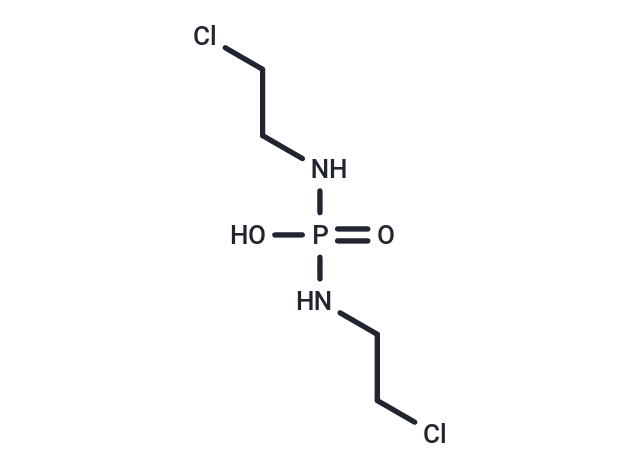Shopping Cart
Remove All Your shopping cart is currently empty
Your shopping cart is currently empty
Palifosfamide (Isophosphamide mustard) lysine (ZIO-201) is a stable form of palifosfamide. Palifosfamide lysine has broad activity in sarcoma lines in vitro. The IC50 ranges from 2.25 to 6.75 μM for most cell lines except OS222 (IC50=31.5 μM).

| Pack Size | Price | USA Warehouse | Global Warehouse | Quantity |
|---|---|---|---|---|
| 1 mg | $70 | In Stock | In Stock | |
| 2 mg | $98 | In Stock | In Stock | |
| 5 mg | $172 | In Stock | In Stock | |
| 10 mg | $289 | In Stock | In Stock | |
| 25 mg | $452 | In Stock | In Stock | |
| 50 mg | $596 | In Stock | In Stock | |
| 100 mg | $863 | In Stock | In Stock |
| Description | Palifosfamide (Isophosphamide mustard) lysine (ZIO-201) is a stable form of palifosfamide. Palifosfamide lysine has broad activity in sarcoma lines in vitro. The IC50 ranges from 2.25 to 6.75 μM for most cell lines except OS222 (IC50=31.5 μM). |
| Targets&IC50 | OS222:31.5 μM |
| In vitro | Differential gene expression of ALDH3A1 but not ALDH1A1 is noted in the OS31 xenograft. Stabilized palifosfamide administered to mice suppresses MX-1 tumor growth by greater than 80% with 17% complete antitumor responses. Oral bioavailability in rats is 48-73% of parenteral administration, and antitumor activity in mice is equivalent by both routes. Treatment with palifosfamide-tris combined with docetaxelor doxorubicin at optimal regimens results in complete tumor regression in 62-75% of mice. |
| Cell Research | Palifosfamide is dissolved in phosphate buffered saline (PBS). Cells are plated in 96-well microtiter plates with approximately 500 cells per well in 100 μL of media. After 24 h of incubation at 37°C, cells are treated with increasing concentrations of palifosfamide lysine in separate plates either as a single-day treatment or three consecutive days of treatment, with fresh drug being added each day. The plates are incubated for 72 h at 37°C with 5% CO2. After 72 h, 250 μg of MTT is added to each well and incubated at 37°C for 6 h. MTT is converted to formazine crystals by mitochondria of viable cells, which are then dissolved in 100 μL of dimethyl sulfoxide. Optical density is measured at 595 nm. |
| Animal Research | Mouse: CB17 female SCID mice are used in the study. Once the tumors reached 50–150 mm3, mice are randomized into control and treatment groups (5-8 mice/group) for each tumor line. Cyclophosphamide is administered at the dose of 150 mg/kg intraperitoneally once a week for 6 weeks. Palifosfamide lysine is administered intravenously at the maximum tolerated dose of 100 mg/kg for three consecutive days as a one-time treatment and serial tumor volumes are determined over the next 6 weeks. Mice are sacrificed at the end of the experiment. |
| Synonyms | ZIO-201, Isophosphoramide mustard, Isophosphamide mustard |
| Molecular Weight | 221.02 |
| Formula | C4H11Cl2N2O2P |
| Cas No. | 31645-39-3 |
| Smiles | P(NCCCl)(NCCCl)(=O)O |
| Relative Density. | 1.411 |
| Color | Transparent |
| Appearance | Viscous |
| Storage | Pure form: -20°C for 3 years | In solvent: -80°C for 1 year | Shipping with blue ice/Shipping at ambient temperature. |
| Solubility Information | DMSO: < 1 mg/mL (insoluble or slightly soluble) |
| Size | Quantity | Unit Price | Amount | Operation |
|---|

Copyright © 2015-2025 TargetMol Chemicals Inc. All Rights Reserved.